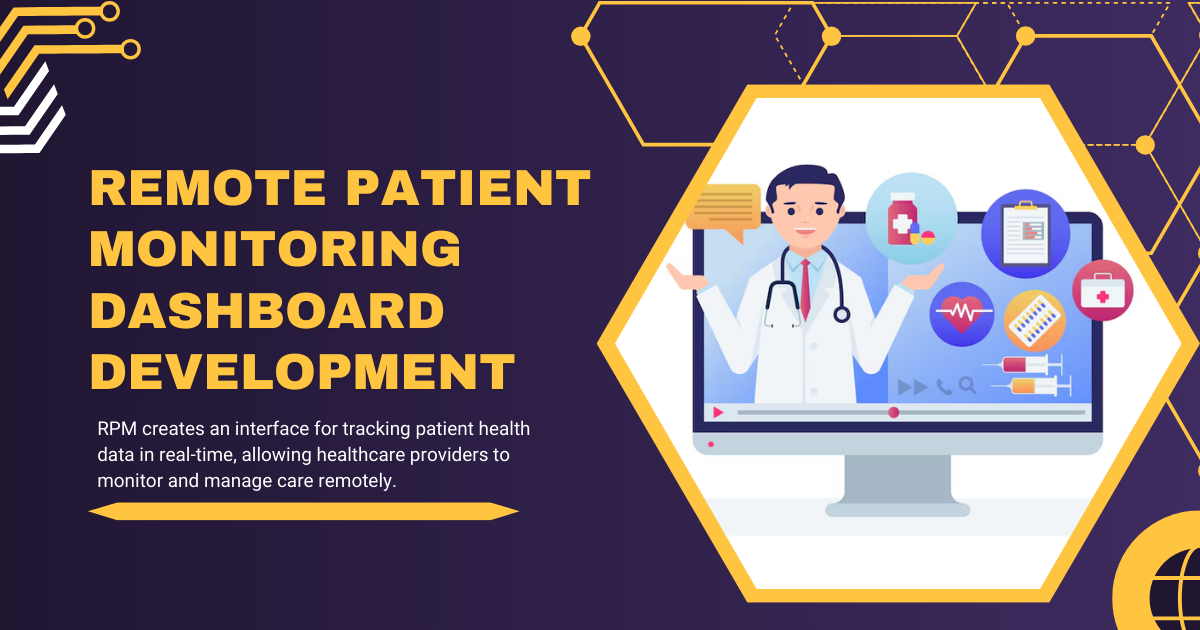Remote Patient Monitoring (RPM) is transforming the healthcare landscape by allowing healthcare providers to monitor patients' health from a distance. This innovative approach is facilitated by Remote Patient Monitoring Dashboards, which offer a centralized platform for tracking and managing patient data. This article delves into the development of these dashboards, exploring their features, benefits, technical aspects, and future trends.
What is a Remote Patient Monitoring Dashboard?
A Remote Patient Monitoring Dashboard is a digital tool that enables healthcare providers to monitor patients' vital signs and health metrics remotely. These dashboards integrate data from various sources, including wearable devices and medical sensors, into a unified interface.
Key Features of RPM Dashboards
- Real-Time Data Tracking: Provides live updates on patients' health metrics, such as heart rate, blood pressure, and glucose levels. This helps in timely intervention if any abnormalities are detected.
- Customizable Interfaces: Allows healthcare providers to tailor the dashboard to their needs, displaying the most relevant data and metrics in an easily accessible format.
- Integration with Medical Devices: Connects seamlessly with various medical devices to automatically collect and update patient data, ensuring accuracy and efficiency.
- Alerts and Notifications: Sends automatic alerts for any irregularities or urgent issues, enabling prompt action and reducing the risk of severe complications.
- Data Visualization: Utilizes charts, graphs, and other visualization tools to present data in a user-friendly manner, facilitating better understanding and analysis.
- Secure Access: Ensures data protection through secure login systems and encryption, safeguarding sensitive patient information from unauthorized access.
- Analytics and Reporting: Generates comprehensive reports and analytics on health trends, helping providers track patient progress and make informed decisions.
Benefits of Remote Patient Monitoring Dashboards
- Improved Patient Outcomes: By allowing continuous monitoring, RPM dashboards help in early detection of potential health issues, leading to better patient outcomes and reduced hospitalizations.
- Increased Efficiency in Healthcare: Reduces the need for frequent in-person visits, saving time and resources for both patients and healthcare providers.
- Enhanced Patient Engagement: Empowers patients by providing them with access to their health data and progress reports, encouraging them to be more involved in their care.
- Cost Savings for Healthcare Providers: Lowers healthcare costs by minimizing the need for emergency interventions and hospital visits through proactive management.
Technical Aspects of Dashboard Development
- Data Collection and Integration: Involves aggregating data from multiple sources, including wearables and medical devices, ensuring that the dashboard presents a comprehensive view of the patient's health.
- User Interface and Experience Design: Focuses on creating intuitive and user-friendly interfaces that enhance usability and facilitate easy navigation for healthcare providers.
- Security and Privacy Considerations: Implements robust security measures to protect patient data, including encryption, secure login systems, and compliance with privacy regulations.
- Scalability and Performance: Ensures that the dashboard can handle increasing amounts of data and users while maintaining performance and reliability.
Case Studies and Examples
- Case Study 1: Chronic Disease Management: Demonstrates how RPM dashboards help in managing chronic conditions like diabetes and hypertension by providing continuous monitoring and early alerts.
- Case Study 2: Post-Surgery Care: Highlights the benefits of RPM dashboards in monitoring post-surgical patients, tracking recovery, and detecting complications early.
- Case Study 3: Elderly Care: Showcases the use of RPM dashboards in monitoring elderly patients, ensuring their health and safety, and reducing the need for frequent in-person check-ups.
Challenges in Developing RPM Dashboards
- Data Accuracy and Reliability: Ensuring that data collected from various sources is accurate and reliable is crucial for effective monitoring and patient care.
- User Adoption and Training: Overcoming resistance to new technology and providing adequate training to users are essential for successful implementation.
- Integration with Existing Systems: Integrating RPM dashboards with existing healthcare systems and electronic health records can be challenging but is necessary for seamless operations.
Future Trends in Remote Patient Monitoring Dashboard Development
- AI and Machine Learning Integration: The use of AI and machine learning algorithms to analyze patient data and predict health trends is expected to enhance the capabilities of RPM dashboards.
- Enhanced Data Analytics: Advances in data analytics will enable more detailed insights and personalized care recommendations based on patient data.
- Expansion of Telemedicine Services: As telemedicine continues to grow, RPM dashboards will play a key role in supporting remote consultations and follow-ups.
Choosing the Right Remote Patient Monitoring Dashboard Development Service
- What to Look for in a Service Provider: Evaluate potential service providers based on their experience, technical expertise, and ability to customize solutions to meet your needs.
- Questions to Ask Before Hiring: Inquire about their approach to data security, integration capabilities, and support services.
- Evaluating Service Provider Capabilities: Consider their track record, client testimonials, and ability to deliver a solution that aligns with your requirements.
Conclusion
The development of Remote Patient Monitoring Dashboards represents a significant advancement in healthcare technology. By providing real-time monitoring, secure data management, and comprehensive analytics, these dashboards offer valuable tools for improving patient care and operational efficiency. As technology continues to evolve, RPM dashboards will play an increasingly important role in the future of healthcare.




.png)

Comments